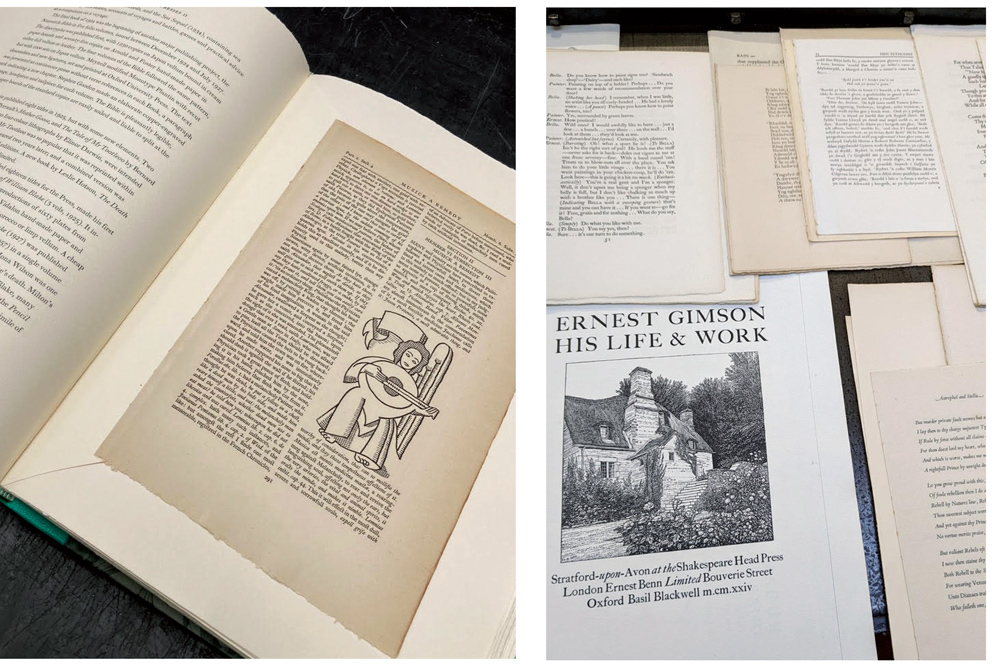*The Editor was told that Colin had died shortly after the release of Parenthesis 46. He was a staunch supporter of the FPBA and wrote many learned and entertaining articles and reviews for Parenthesis. He will be greatly missed.
‘Unused sheets have become elusive, and it is thanks both to perseverance and luck that this compilation has been possible: a similar venture is extremely unlikely in the future’ predicted David McKitterick in his review of Pages from Presses (the Whittington Press, 2006) in Parenthesis 14 (February 2008). That volume included pages from six presses: Kelmscott, Ashendene, Doves, Eragny, Vale and Essex House. Never one to sidestep a bibliophilic challenge, David Butcher, who had provided commentaries on those six presses, accepted McKitterick’s challenge. Now we have his second magnum opus Pages from Presses II (the Whittington Press, 2022), distributed to its subscribers in autumn 2023. ‘Only one of the six presses in the first volume was still in operation after the First World War,’ notes Butcher in his introduction. His commentary on a further seven presses, Golden Cockerel, Gregynog, Shakespeare Head, Curwen, Nonesuch, Haslewood Books and Cresset, is a lucid distillation of great knowledge lightly worn. Butcher’s triumvirate of these presses is Gregynog, Nonesuch and Golden Cockerel, with the latter ‘the greatest of its generation.’ He also provides a succinct chronology of the presses’ activities and interactions spanning eight decades, from the foundation of the Shakespeare Head Press in 1904 to the closure of the Curwen Press in 1983.

Opposite right: Some of the specimen pages included in Pages from Presses Volume II, including the title page for William Lethaby, Ernest Gimson: His Life and Work, with illustrations by F L Griggs.The Shakespeare Head Press, 1924.
Butcher has spent 15 years collecting specimen pages from books published by the seven presses. Recently he came across a 2009 reference to Christopher Rowlatt’s boldly patterned green endpapers which must have been marbled then or soon after. As a physical object the green cloth-covered solander box housing the A edition is impressive. Bound in vibrant green full Nigerian Goatskin, the book within is sumptuous. Books should not be judged their covers, however, opening this one fully requires a large desk or table. It is not to be read by the fire. Facing the title page is a tipped-in folded broadsheet which, when opened, displays the press marks of the seven presses, printed from magnesium plates. When Harold Midgely Taylor founded the Golden Cockerel Press in 1920 he named it after the Russian Ballet Coq d’Or. A cluck of roosters shows how later owners redesigned its press mark. Butcher’s four-page introduction is followed by his commentary on the seven presses, ranging from 16 to 22 pages in length. Each press commentary provides all a general reader needs to know of its history and achievements. Specimen leaves from selected books published by the presses are tipped onto guards so that they can be turned naturally and studied on both sides. These specimens show each press’s type design, layout, exact format, quality of inking and impression. Wood engravings are the most common illustrations, including examples by Eric Gill, Robert Gibbings, John Nash (some stencil-coloured), Lynton Lamb, Mary Groom, John Buckland Wright, R A Maynard, H W Bray, Agnes Miller Parker, John Farleigh, and Edward McKnight Kauffer (most hand-coloured using stencils). Other print techniques used include copper-engravings by Edward Wadsworth, and Stephen Gooden, and dry points by Richard Wyndham. Other illustrative material includes wood-engraved initials by Gill and Jan van Krimpen (in red), headings and initials by Joscelyne Gaskin, and ornaments designed by Rudolf Koch. In edition A, many of the pages with wood engravings, stencil-coloured illustrations and copper engravings are double leaves, showing four pages. Three show typefaces designed for those presses. In edition B, some wood engravings or other illustrations and initials are in a second colour, several are double leaves, showing four pages.
Pages from Presses II will probably be the last letterpress book published by Whittington, so it is apposite that the paper used bears its watermark for the first time. We could speculate on which contemporary presses might appear in any further compilation of ‘pages from presses’ decades hence however, without a shadow of doubt, Whittington Press would be any bibliophile’s first choice.
Publication details
180 copies set by Neil Winter in 14D Walbaum and printed by Ellen Bills and Patrick Randle at Whittington on Czech Losin handmade paper. Accompanied by original leaves from each of the seven presses. Bound by the Fine Book Bindery, Finedon, with papers marbled by Christopher Rowlatt.
Edition A: 45 copies, numbered I-XLV, bound in full Nigerian Goatskin, with 27 original leaves, and a separate portfolio of additional leaves, in a solander box. £3,450 (Out of print).
Edition B: 40 copies, numbered i-xl, bound in half Nigerian Goatskin, with 19 original leaves. £1450.
Edition C: 95 copies, numbered 1-95, bound in half buckram with Fabriano Roma sides, with 14 original paper leaves, in a slipcase. £445 (Out of print).
